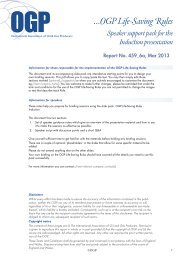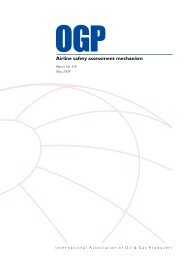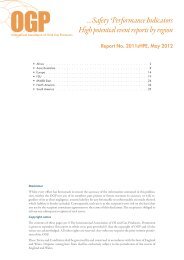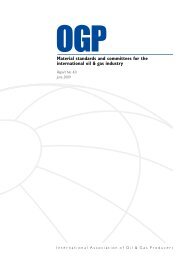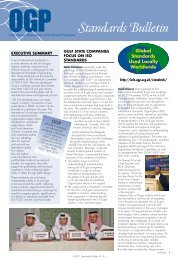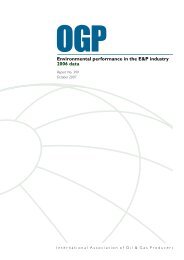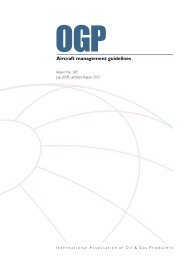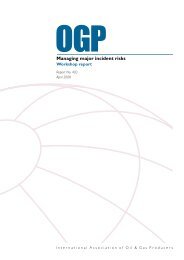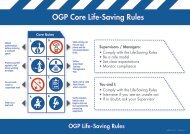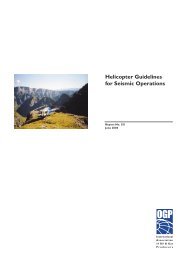Helicopter guidelines for land seismic & helirig operations - OGP
Helicopter guidelines for land seismic & helirig operations - OGP
Helicopter guidelines for land seismic & helirig operations - OGP
You also want an ePaper? Increase the reach of your titles
YUMPU automatically turns print PDFs into web optimized ePapers that Google loves.
<strong>Helicopter</strong> <strong>guidelines</strong> <strong>for</strong> <strong>land</strong> <strong>seismic</strong> & <strong>helirig</strong> <strong>operations</strong><br />
F.4 Line helipads in <strong>for</strong>est or jungle areas<br />
The work involved in clearing trees, primary or secondary <strong>for</strong>est/jungle, even to 1m level is<br />
considerable and the removal of tree trunks is unlikely to be achieved with the resources of a<br />
helicopter supported <strong>seismic</strong> party. In order to achieve a flat area, clear of immediate obstructions<br />
allowing transition between the hover and <strong>for</strong>ward flight, it will often be convenient, especially in<br />
areas prone to flooding, to construct a raised helipad. However, the rate of decay and destruction<br />
by insects of softwoods in tropical climates should not be underestimated. Whenever raised<br />
wooden helipads are used, the following procedure is recommended:<br />
1. Upon first construction: inspection and release to service by the senior pilot (that will also<br />
include a check of the entire clearing <strong>for</strong> correct dimensions and freedom from obstructions).<br />
2. Two months from construction: inspection by a ground party who may be brought in<br />
by helicopter provided the pilot is briefed and able to keep the helicopter light on the<br />
undercarriage. Subject to findings during this check, the <strong>land</strong>ing site may be released to<br />
service <strong>for</strong> a further month.<br />
3. Three months from construction: complete rebuild of elevated helicopter <strong>land</strong>ing plat<strong>for</strong>m<br />
and pre-release inspection.<br />
For more permanent <strong>land</strong>ing sites consideration should be given to using hardwood planks;<br />
the structure, which will also be subject to a three month inspection interval, may be repaired<br />
on condition. Should the <strong>seismic</strong> campaign run into a drilling campaign, then all pads to be<br />
used by rig support aircraft should be constructed of hardwood. Used engine oil has been found<br />
effective as a hardwood preservative, and using this method, no deterioration was noticed after<br />
eight months. However, should oil be used as a preservative then due attention will have to be<br />
paid to ensure the environment is not contaminated during the application of the oil.<br />
When short sling loads are to be handled in standard clearings, it is essential that an area free<br />
of obstruction, of approximately 5 meters square and above the level of stumps/felled trees, be<br />
made available. Although the <strong>land</strong>ing area may be used <strong>for</strong> this purpose, in order that loads may<br />
be prepositioned without prejudicing the ability to <strong>land</strong> a helicopter with passenger or internal<br />
loads, it has been found convenient to prepare secondary pads, displaced at least 5 meters from<br />
the main <strong>land</strong>ing area.<br />
Fly camps should be set up well inside the tree line so as not to intrude into the cleared area. This<br />
serves to avoid the danger from falling trees rendered unstable by the clearing process, and to<br />
distance tarpaulins and other loose camp equipment from the rotor downwash, which may lift<br />
items into blades or engine intakes with disastrous results. It will also protect personnel from<br />
the danger of flying debris in the event of a helicopter crash <strong>land</strong>ing at the helipad.<br />
It is also essential to brief personnel not to set up the fly camp in the area directly under the<br />
approach and overshoot flight path since in the event of an engine malfunction during sling<br />
<strong>operations</strong> the pilot will release the load to gain additional per<strong>for</strong>mance from the helicopter.<br />
© <strong>OGP</strong><br />
63



